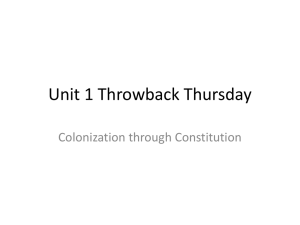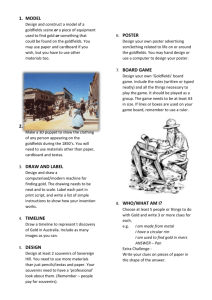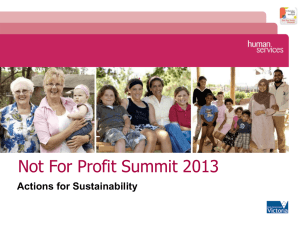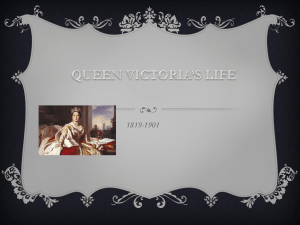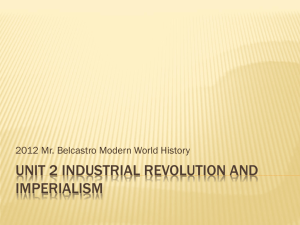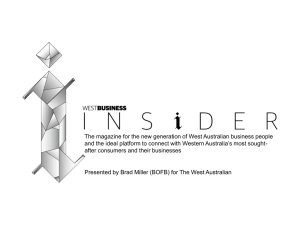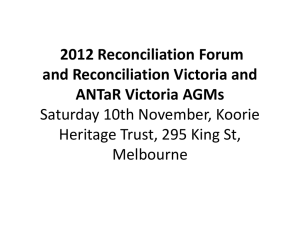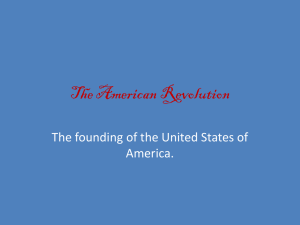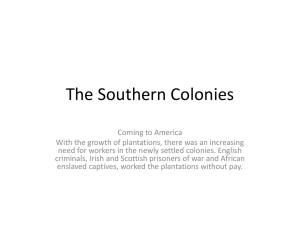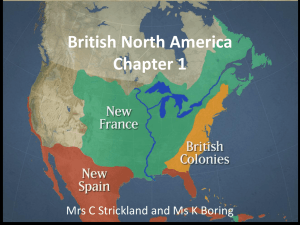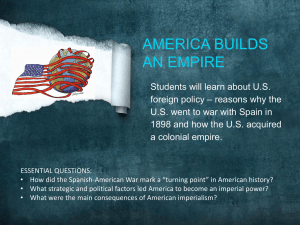Life in Colonial Victoria
advertisement
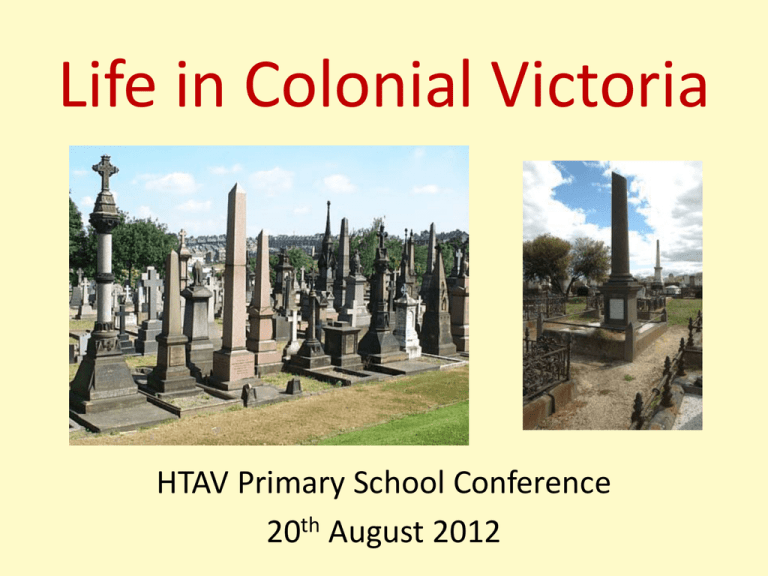
Life in Colonial Victoria HTAV Primary School Conference 20th August 2012 The Australian Curriculum: History is organised into two interrelated strands: Historical Knowledge and Understanding and Historical Skills. Historical Knowledge and Understanding Content descriptions specify what teachers are expected to teach elaborations illustrate the content descriptions History / Year 5 / Content Descriptions Historical Knowledge and Understanding The Australian Colonies Reasons (economic, political and social) for the establishment of British colonies in Australia after 1800. (ACHHK093) The nature of convict or colonial presence, including the factors that influenced patterns of development, aspects of the daily life of the inhabitants (including Aboriginal Peoples and Torres Strait Islander Peoples) and how the environment changed. (ACHHK094) The impact of a significant development or event on a colony; for example, frontier conflict, the gold rushes, the Eureka Stockade, internal exploration, the advent of rail, the expansion of farming, drought. (ACHHK095) The reasons people migrated to Australia from Europe and Asia, and the experiences and contributions of a particular migrant group within a colony. (ACHHK096) The role that a significant individual or group played in shaping a colony; for example, explorers, farmers, entrepreneurs, artists, writers, humanitarians, religious and political leaders, and Aboriginal and/or Torres Strait Islander peoples. (ACHHK097) History / Year 5 / Historical Knowledge and Understanding / The Australian Colonies Content description The impact of a significant development or event on a colony; for example, frontier conflict, the gold rushes, the Eureka Stockade, internal exploration, the advent of rail, the expansion of farming, drought. Elaborations • investigating an event or development and explaining its economic, social and political impact on a colony (for example the consequences of frontier conflict events such as the Myall Creek Massacre, the Pinjarra Massacre; the impact of South Sea Islanders on sugar farming and the timber industry; the impact of the Eureka Stockade on the development of democracy) • creating ‘what if’ scenarios by constructing different outcomes for a key event, for example ‘What if Peter Lalor had encouraged gold miners to pay rather than resist licence fees?’ http://www.australiancurriculum.edu.au/Year5?a=H&layout=1 The Australian Curriculum, History Key inquiry questions Year 5 The Australian Colonies in the 1800s 1. What do we know about the lives of people in Australia’s colonial past and how do we know? 2. How did an Australian colony develop over time and why? 3. How did colonial settlement change the environment? 4. What were the significant events and who were the significant people that shaped Australian colonies? What do we know about the lives of people in Australia’s colonial past and how do we know? Queen Victoria [ 1819-1901 ] By Franz Xaver Winterhalter 1837 Victoria crowned Queen of Great Britain and Ireland Queen Victoria's family in 1846 by Franz Xaver Winterhalter left to right: Prince Alfred and Prince Albert, the Prince of Wales; the Queen and Prince Albert; Princesses Alice, Helena and Victoria 1840 The Penny Post is introduced in Britain George Baxter, News from Home 1854 George Baxter, News from Australia 1854 [Penny post 1840] The Vulcan, the first steam locomotive on the Great Western Railway. It ran on a short stretch of completed track on 28 December 1837. 1838 1839 1841 1843 1849 1850 Oliver Twist Nicholas Nickleby The Old Curiosity Shop A Christmas Carol David Copperfield began his weekly journal Household Words. Charles Dickens 1812 - 1870 Frontispiece, first edition 1838 The Victorian Christmas First edition frontispiece and title page (1843) The Queen's Christmas tree at Windsor Castle. First commercially produced Christmas card, designed by John Callcott Horsley for Henry Cole 1843 Illustrated London News, 1848 Edward Jenner by James Northcote 1840 Smallpox vaccination - using cowpox - provided free in Britain - other treatments of smallpox banned Colonization spread Britain’s Industrial Revolution, culture, language, religion and politics to Australia. Henry O’Neil, The Parting Cheer An artist's impression of John Batman's treaty with Port Philip aborigines in 1835 for the purchase of 600,000 acres of land. The Australian Sketchbook by S. T. Gill, 1865. S. T. Gill, Attack on Store Dray S. T. Gill, Homeward Bound S. T. Gill. Wool Drays S. T. Gill. Bushman’s Hut S.T. Gill, Cattle Branding Ercildoune near Lake Burrumbeet Von Guerard, Eugene, Koort Koort-nong homestead, near Camperdown, Victoria 1860 S. T. Gill, The New Rush Main Street, Sovereign Hill Museum (Ballarat 1851 – 1861) Replica mud brick and bark dwelling at Sovereign Hill (secondary source) Interior of mud brick and bark colonial dwelling at Sovereign Hill Bark House, January 1883 (primary source) Chimney crane in dwelling at Sovereign Hill Speedwell Street, Sovereign Hill – recreated dwellings c. 1854 (secondary source) Cottage at Ross Creek, near Ballarat c 1871-2 (primary source c.f. Speedwell Street, Sovereign Hill) At Sovereign Hill costumed volunteers can often be seen working in the recreated cottages. (Secondary source) Pierre-Édouard Frère , Washing Day c 1878 (Primary source) Post Office kitchen at Sovereign Hill B class locomotive, Ballarat c. 1864 Ballarat produce market – next to railway station c.1860s Part of cargo for sailing ship 'Samaco' specially chartered for Hugh V. McKay's machinery train load of Sunshine Harvesters leaving Ballarat for export to Argentina 1903 Oxley Museum, Wellington NSW Early stump jump plough – first invented in 1876 Old Ballarat Cemetery Creswick Rd, Ballarat History Achievement Standard By the end of Year 5, students • identify the causes and effects of change on particular communities, and describe aspects of the past that remained the same. • They describe the different experiences of people in the past. • They describe the significance of people and events in bringing about change. • Students sequence events and people (their lifetime) in chronological order, using timelines. • When researching, students develop questions to frame an historical inquiry. • They identify a range of sources and locate and record information related to this inquiry. • They examine sources to identify points of view. • Students develop, organise and present their texts, particularly narratives and descriptions, using historical terms and concepts. RESOURCES 2. Flies! – William Howitt (mp3 file) “ The little black-devil fly all day attacked our eyes, nose and mouth: and great blowflies in thousands blew our blankets, rugs and everything woollen, all over with their maggots, which were at once dried upon by the sun. They covered spaces of a foot square at once with them, all adhering by a sort of gluiness.” (William Howitt Land, Labour and Gold; or Two Years in Victoria Longmans, London, 1855 quoted in Nancy Keesing (ed) History of the Australian Gold Rushes by those who were there. Angus and Robertson, Melbourne 1981 edition. P 110) http://sheducationcom.ascetinteractive.biz/?id=audiolibrary#Flies Search Sovereign Hill Education Teachers → Pod Casts (Primary Sources) → Audio Library → Flies. S. T. Gill, Butchers Shamble, Forest Creek USEFUL WEB SITES for Australian History Life in Colonial Victoria TROVE http://trove.nla.gov.au/ THE PUBLIC RECORDS OFFICE OF VICTORIA (PROV) http://prov.vic.gov.au/ SOVEREIGN HILL www.sovereignhill.com.au/education HISTORY PIN www.historypin.com/community-schools/
